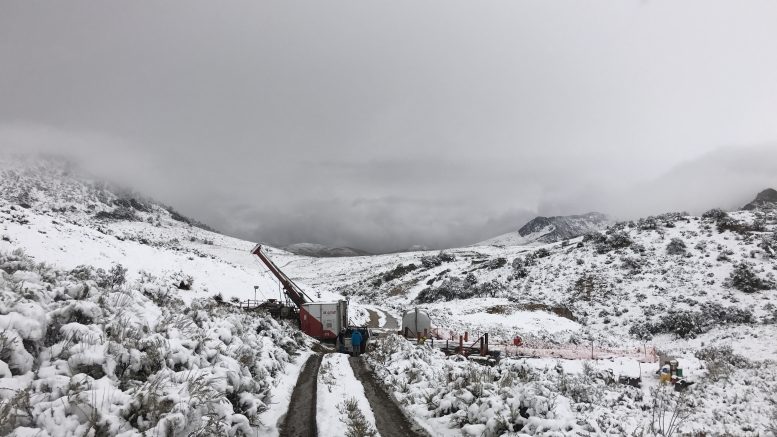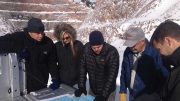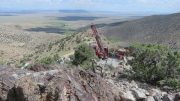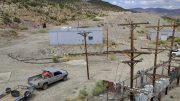VANCOUVER — Expect to hear a lot more about Contact Gold (TSXV: C), president and CEO Matthew Lennox-King says. The new junior explorer is more than halfway through an 8,000-metre drill program at its Pony Creek gold property, located south of Gold Standard Ventures’ (TSXV: GSV; NYSE-AM: GSV) Railroad-Pinion gold property in Nevada’s Carlin gold trend.
Contact’s intention is to expand upon a historical resource at the property’s Bowl Zone, and test for similar Carlin-style mineralization 3 km north at the Pony Creek North prospect.
Both targets occur within the Moleen geological formation, the same package of rocks that hosts Gold Standard’s 1 million oz. Dark Star gold deposit.
The more traditional host of Carlin-style deposits, the Webb formation, also occurs across Contact’s 95.4 sq. km property. (The Webb hosts Newmont Mining’s [NYSE: NEM] Rain and Emigrant gold mines, 30 km north of Pony Creek, and Gold Standard’s 1.7 million oz. Pinion gold deposit.)
“We have all the right rocks and the fact they haven’t really been worked is exciting,” Lennox-King tells The Northern Miner during a phone interview. “We have our base case with the historic deposit at the Bowl Zone, and we can definitely offer growth by capitalizing on some of the lessons learned from Gold Standard — do some good science, fund it well, and you’ll ultimately create a lot of value.”
Contact’s latest drill results have stepped out 50 to 100 metres from Bowl’s historic resource of 29.4 million tonnes of 1.51 grams gold per tonne for 1.4 million oz. gold.
Lennox-King says the results are “pretty typical of Carlin-style grades and definitely in line with our expectations,” with some higher-grade intervals that are “pretty significant, whether you’re in the Carlin trend or Ontario.”

Location map of Contact Gold’s Pony Creek gold property relative to major projects and mines in the region. Credit: Contact Gold.
Higher-grade intercepts include 45.7 metres of 2.82 grams gold, including 6.1 metres of 10.53 grams gold, and 65.5 metres of 0.65 gram gold from 62 metres, including 18.3 metres of 1.48 grams gold.
“The Bowl resource is not current, but a good proxy for what’s there,” he says, noting that most of the historical holes reached 150 metres depth. “Our goal wasn’t to just go in, twin a bunch of holes and say we’re really clever. We’re pushing these drill holes into white space where there’s no mineralization — we want to find out what’s there.”
Lennox-King expects to get its first drill results from Pony Creek North in the coming weeks. The company was drawn to the target because of a lone drill hole, completed in 1989 by Barrick Gold, that returned 43 metres of 0.47 gram gold.

Carlin-style mineralization in drill core from Contact Gold’s Pony Creek property in Nevada. Credit: Contact Gold.
“Back then, an intercept like that isn’t considered ore. But today in Nevada, you can definitely make the case that it is,” he says. “So our program will expand the footprint of that drill hole. We think it’s one of the low-hanging areas where we can define a new resource in a relatively short time frame.”
Pony Creek had been explored since the mid-1980s, but the project sat dormant over the past decade due to poor market conditions.
Ever since Contact went public in June, the company has ramped up exploration at Pony Creek, adding over 7,000 soil samples to the existing geochemical database, and conducting geophysical surveys to home in on potential ore-bearing structures.
Results from the generative work have yet to be announced.
Mineralization occurs along a web of north-trending structures that once acted as passageways for gold-bearing fluids into permeable strata. The fluids reacted with chemically favourable rock units, such as limestones, dissolving the carbonate and depositing gold.
The faults follow in-line with a swarm of quartz-feldspar porphyry dykes and intrusions, which are variably hydrothermally altered and locally mineralized.

View of the historic resource area at Contact Gold’s Pony Creek gold property in Nevada. Credit: Contact Gold.
The geological context makes the property relatively easy to explore, Lennox-King says.
“What hasn’t been done on the property is a concerted, well-funded, year-over-year effort. Major companies would come in and drill some holes, then move onto other opportunities like building a mine. Or junior companies become so poorly financed they can’t have that year-over-year program. It’s telling what you can do with a good geological platform and having an aggressive, consistent effort — just look at Gold Standard.”
Contact intends to update the resource at Pony Creek by the third quarter of next year and continue exploring the rest of the property.
“What we acquired was a really nice canvas — someone started off a great sketch and now we’re filling with a larger pallet to paint a better picture,” he says.
Shares of Contact have traded within a 52-week range of 55¢ to $2 apiece, and closed at 60¢ at press time. The company has 50.3 million shares outstanding, for a $30 million market capitalization.






Be the first to comment on "Contact Gold explores upside at Pony Creek"